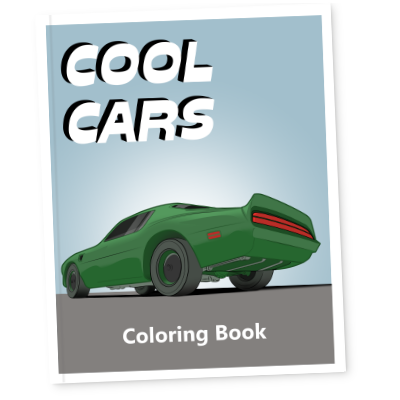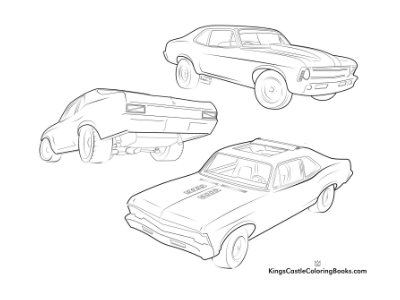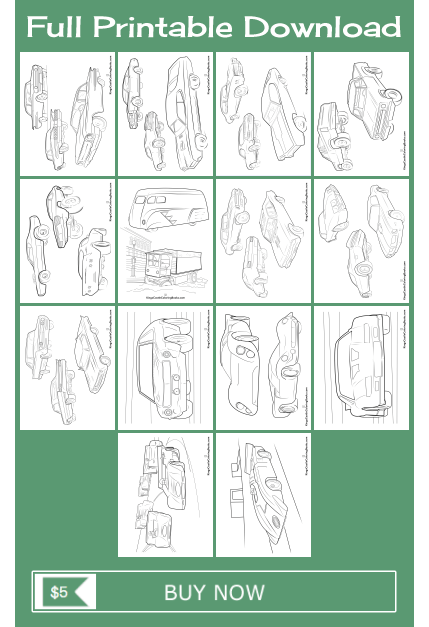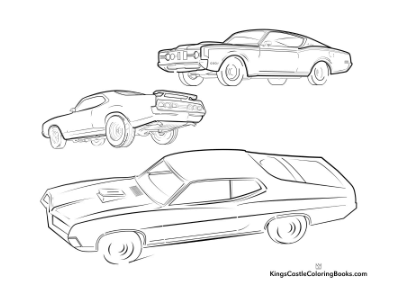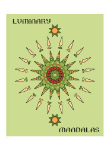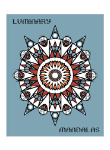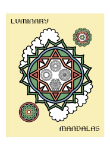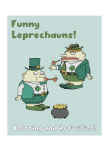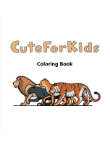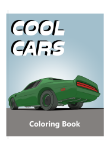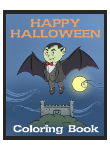cool car coloring books!
|
Get to the starting line with your crayons and pencils! Imagine a garage full of 32 Cool Cars |
Scroll for Free Samples!
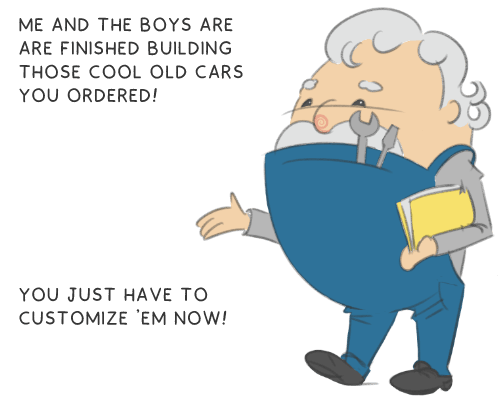 | |
|
Already ordered your Cool Cars Coloring Book? |
Cool Car Coloring books
|
Can't wait to push the pedal to the metal? |
Cool Cars
Free Printable Downloads
Drag that black crayon across the page. It's a burnout!
Muscle Cars never die - they just go faster!
Enjoy this Free Printable Download - a sample from our upcoming cool car coloring books!
Different cars look best in different colors.
You can try as many color combinations as you like
with this Free Printable Download!
These pictures and more are part of our
Cool Car Coloring Books!
What outrageous paint schemes can you come up with for these handsome brutes?
With these Free Printable Downloads, you can explore limitless experiments!
Our Cool Car coloring books put you in the Driver's Seat!
Explore your own unique automotive artistry
with 32 Cool Cars to color any way you like!
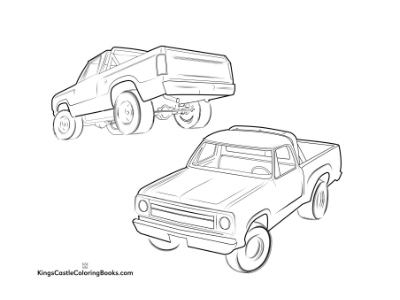
Here's another picture from our cool car coloring books!
This one is for the four-wheelin' demons!
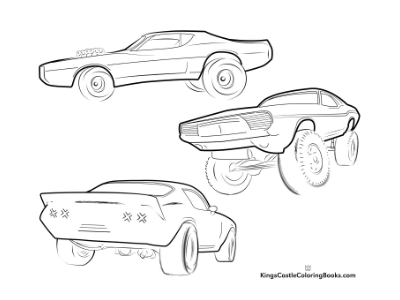
Sometimes folks get a hold of a muscle car and fix it up to go
four-wheeling or rock-climbing! Crazy!
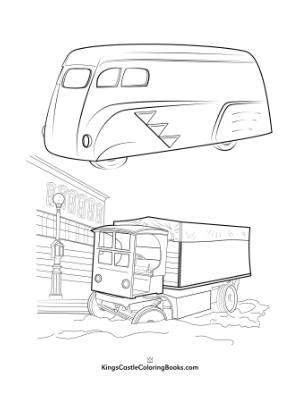
Electric cars are nothing new!
In the old days, electricity was used to power all sorts of heavy-duty vehicles!
You can get these coloring pages and more in our Cool Car Coloring Books!
the first muscle car?
There is an argument to be made, there is no “first muscle car”.
Contrary to popular stories, the concept was not invented in 1964, but the word “muscle car”did gain popularity
that year. The actual word “muscle” was used many times in automobile marketing campaigns throughout the years.
In the 1960s, Pontiac wasn't racing professionally anymore.
By 1964, the dilemma was, they had to convince customers their products were still exciting.
Instead of Pontiac using their new slogan “Performance Street Machines” by accident or design, they came across “Muscle Car”!
Pontiac realized their marketing campaign for the 1965 GTO!
Muscle Car Mania!
When the Highways were new, Dad's car looked like a rocket ship.
Between 1966 and 1972, America was literally car crazy - “Muscle Car Crazy” to be specific.
52 states had multiple cities hosting drag strip entertainment.
A little place like Massachusetts had six cities dragging cars on the regular.
“Spectator Drags,”
“Run what ya' Brung”
“Original Equipment Day,”
Auto enthusiasts bought cars with no fancy options and awesome power-trains for weekend “Drag racing.”
American “Road Trip Culture” peaked during this time, a key ingredient for the booming home-grown drag strips.
Renting to local gear heads in the off seasons proved a profitable business model for the drag strips as well.
“Van Culture” thrived during the drag racing era.
Drag Racing Events in the 1960s was the hobby for over half the American population.
Fans and crews followed local racers to other cities, battling muscle cars at rival tracks. What a country!
And what a coloring book!
Looking for Cool Car coloring books with lots of
muscle cars?
We've got just the thing!
Traditional colors, like red and black, have always been
popular on muscle cars, but the late 60s paved the way
for wild new colors like Plum Crazy, Hugger Orange and
Sublime Green!
The Cool Cars Coloring Book is packed
with 32 Cool Cars to "paint" any way you like!
What is a spectator drag?
Also referred to as "Run what ya' Brung", the Spectator Drag events are local racetracks giving audience members a chance to race one lap with their own car against another spectator.
Spectator events, usually held after all scheduled track entertainment, concludes for the night.
Sometimes the track would hold grudged matches with the winners.
Although, often spectator races would run long into the night. The track may not have time for extra events.
Typically, there are no prizes, trophies or consolations. Everyone who participates in the event understands
the probability of injury. There is also the real risk of crashing your car. Some guys crash on purpose for a laugh,
believe it or not!
Some just like to take home "Braggin' Rights", For a lot of car guys that's a good enough excuse to enter the race.
Also, it's a legal environment. Folks can really push an engine to see what it's got.
Some would answer the question by saying, "watching idiots attempt to race cars".
The more optimistic would disagree. Seeing it as entertainment, thrills, unlikely participants, unexpected crashes,
extreme mechanical failures and amazing cars people pull out of their garage to compete with.
The attributes of the "spectator drags events" accomplishes an unpredictable electrifying outdoor event,
yielding stories that will be repeated over and over at backyard fire pits for generations.
Relive the start line anticipation, roar of the engines, clamor of the crowd, rumble of exhaust, wailing burn outs,
explosive crashes, the frenzy of victory and the agony of defeat with our car coloring books.
What is a muscle car?
The term is used to describe a certain era and class of automobile that was sold to the public around the
years 1966 to 1972.
A sleek, powerful, affordable daily driver. A car ready for drag racing right out of the show-room.
In the early years, mid-size rear-wheel, two doors with over sized v-8 engines didn't have suspensions
to accommodate their own force. Muscle cars had a tendency to appear outrageous -
but they were all built for a purpose: to go fast on a straight trajectory.
In the 1970s, the muscle cars were kept alive in the after-market world.
The big auto makers no longer took part, focusing instead on comfort, technology and gas mileage.
Pollution equipment mandates put an end to the show-room-dragster for a while.
The outrageous muscle car ran out of gas as prices everywhere became outrageous.
During the 1980s, the spirit of the muscle car would rise again - and is still with us today -
but the new “muscle cars” are expensive, technological performance vehicles.
Bring back the good ol' days with your car coloring books!
great, great grandpappy’s sports car
Bolting aftermarket parts on an engine isn't a new idea. In fact, the automobile companies copped
the“sports car” idea from common folk. The public was building impressive breakneck cars prior to performance manufacturers and safety industries.
Farmers were the first “aftermarket” parts makers even before the 1800s.
Country living folk were recovering and re-purposing old world farm equipment, cobbling together or
fabricating many parts themselves. Although these guys weren't “sport car” builders, they used
ingenuity to maintain equipment along with countless other heavy duty four wheeled contraptions to
haul goods into the city.
Farmers would inevitably pass their fabricating knowledge on to city dwellers.
In this regard, automotive flair moved quickly from the country to the city.
City folk took up the country farmers “after market” and turned it into “sports car” building.
Developing fabricated personal transportation became a popular pastime.
For the city folks, there was more tooling and fabricating equipment available for their
outrageous mechanical experiments.
Public driving became a lot less safe for driver, passenger, pedestrian and horse.
Cars were destined to go as fast as possible, regardless of whether frames had the structural integrity
to accommodate for the torque, power and speed of the homegrown “aftermarket” aficionado.
Some of these sports car connoisseurs got jobs with crime syndicates as get-away drivers.
The local police had little choice but to invest in their own speed shops, hiring pursuit drivers to keep
up with the competition. Cops and robber car chases were not illegal, venery was competition and all involved
parties were eager to take part. Laws were passed after a while, obviously.
The gangsters started mocking up get away scenarios with fellow partisan drivers to practice the craft of
handling these outrageously powered machines. These “rundowns” became races as time went on.
Males of all ages and occupations were “aftermarket” auto enthusiast long before the sports car
industry got into the game.
detroit diversity 1960s
1960s body styles are so well done they're rarely labeled dated.
Their original equipment still gets praise 60 years later.
Some auto enthusiast go to great lengths to keep them mechanical original because they were mechanically
sound then and considered mechanically sound in modern times.
These cars from yesteryear are so adaptable one can turn them into a modern tech machine.
1960s cars are sought after now every bit as much as they were when they were on the dealers lots.
Honestly, maybe more!
The 1950s auto industry was still primitive in machine technology and tooling facilities.
The concept of making one frame then bolting different bodies and power trains on them was the
standard for automotive manufacturing. From a concept point of view, the cars were all the same except
for trim and creature comforts.
The Chrysler product you bought with a Plymouth brand assigned to it could have been a Cranbrook,
Concord, Cambridge, Plaza, Belvedere or a Fury interchangeably.
Post 1960s Lincoln Mercury models shared wheel bases, right through the Marques styling line ups,
though they had many trim packages.
Oldsmobile had very little distinction between the 88 and the 89 branding.
Chevrolet had a whole catalog of same frame vehicles: 150, 210, Bel Air, Biscayne, Impala including
the wagons Handyman, Townsman, Nomad. You can throw in the Beauville van as well.
By the end of the 1950s, veterans were bringing home cars from overseas. It wasn't long before these
small, agile, zippy imports got noticed by consumer and industry alike.
The major threat for the big three was they had nothing to compete. Worse was these imports were being
modified to go faster and still maintain acceptable gas mileage. A large market of potential buyers
were clamoring for imports by the 1960s.
The Auto industry was ill prepared for the onslaught. They simply didn't have manufacturing or
tooling to make small cars. Starting from the frame up, they could use nothing from the old manufacturing
process for the import sized platforms except bulbs and fasteners.
The first domestic competition off the assembly line was:
Corvair - modeled after the Beetle.
Valiant - styled to make it appear larger.
Falcon - Small Fairlane, single headlight design.
The imports were great for commuting in and around the more congested city street and college towns.
This concept was not lost on the marketers of the big three. Their task was to get customers back
into domestic showrooms.
Advertising for the new smaller vehicles developed into a“hip suburban lifestyle”campaign.
The big three falsely plugged the concept that sprightly compacts were a new American car idea.
Nobody bought in to their claim.
The big three fell short of their own market campaign.
Compared to the imported compact in 1960, the big three introduced“big cars”to their intended market.
Teens at the time claimed the American auto industry was a drag, out of touch with what was on the street.
By now, many used car lots had plenty of tight handling, vivacious imports. Most of these cars had an added bonus.
The previous owner had hopped them up, and of course they were cheaper than a new car.
Another unfortunate truth for the big three was, imports were bought over domestics because American
styling lacked a youthful appeal compared to the slippery curves that captured their attention.
Teenagers were starting to populate the cities and colleges. They didn't want to drive dad's land yacht
and grandpa's dated American car brand just wasn't rebellious enough.
Keep in mind, Hollywood turned every 17-year-old into James Dean.
Sales for the first incarnation of this new car idea were pretty bad considering the entitlement that
the big three came to expect from the buying public.
Having no competition until this point caused them to presume all they had to do was show up with a
new branded product and everything would turn back to normal. But that didn't happen.
Even Chevrolet's Corvette struggled to appeal to the youth market.
The best-selling original American alternative to the import craze was 1960 Chevy Corvair.
32 Cool cars
Muscle car coloring books!
We really like cars - especially the American performance
cars of the late 60s and early 70s - also known as muscle cars.
We know you'll enjoy our Cool Cars Coloring Books
as much as we enjoy making them!
Get Free Samples!
Unsung Muscle of the great era.
By the mid 1960's things began to turn for the big three.
Young buyers where swooned once again by bold new American cars and racing champions.
Today, you don't have to be a gearhead to know that famous old cars rake in huge amounts of money.
1960s and early 1970s classic “muscle cars” Mustang, Camaro, Firebird, Charger and Challenger are some
of the contenders.
At the time, most thought the golden age of muscle cars would never end, horse power increased and
designs got more aggressive as 1972 approached. Most people simply wanted to drive these beasts.
But looking back, it was a short time in automotive history.
Eventually, most of the icons of the era were dropped while companies offered more sensible transportation,
along with other reasons that will not be discussed in this car coloring books article.
Throughout the 1980s, old muscle was a dime a dozen. You could find them sitting around collecting rust.
A lot of these icons were mostly forgotten and weren't expensive when being sold or inherited.
People would tell you something like,“If you can move it, you can have it.”
Some were even tossed in to a deal as a bonus, “I really want that boat,
I'll throw in my ol' 66' Malibu to sweeten the deal.”
But,
as the 1990s grew to a close, even some of the more mundane muscle car packages were high
value cash cows, as long as it has the correct awe inspiring brand name on it.
We are going to leave the icons of the industry and talk about some of the great cars that flew
under the radar at the time. Some of them never had demand and still don't.
That's a good thing now because folks can actually seek one out and purchase it without mortgaging a city, LOL!
Some of these cars are unique, sporting atypical bodies or paint schemes and unpopular power trains.
These machines are just as cool, if not more so because of their rarity and mystery.
They are worth looking into for an enthusiast that longs for a car of the great era.
Unpopular cars of this great age will still provide many hours of fun, restoring or customizing
like any car one might be enamored with.
This is our list. It isn't in any particular order. That isn't the goal of this car coloring books article.
the unsung list
- 1965 Pontiac 2+2 : Majestically designed full-size two-door coupe/convertible based on
the Catalina. Marketed as the GTOs “big brother.” The 2+2, named after the seating arrangement,
two up front and two in the back. Equipped with a 421 cubic-inch V8.
The 376-horsepower version was available with a heavy-duty suspension,
limited-slip differential, and Hurst shifter. The 2+2 is a legit performer
that could hit 60 mph from a standstill in 7.0 seconds and run the quarter-mile in 16 seconds. - 1970 Oldsmobile Rallye : Legendary pedigree from the likes of the Hurst and 442 comes a detuned
Junior muscle car, Intended to compete with a new product group called performance appearance packages. Junior muscle cars were designated owing to handling attributes over outrageous drag strip power, hence the 350 equipped the FE2
The 1970 Rallye, sprayed from bumper to bumper in Sebring yellow, intended to appeal
to the enthusiast who wishes to identify with the a 'performance look'... the NOW look! - 1969 Ford Torino Talladega : NASCAR, the motivation behind homologation specials.
The 1969 constructed from the Fairlane Torino Sports roof platform also got a
reimagined facia dubbed the“Drop Snoot”hiding the head lights and preventing air
from going under the body. The Talladega makes it on the list because it was manufactured
for one year during the mostly forgotten“Aero Wars”of the late 1960s. - 1970 Buick Wildcat : Luxurious muscle for discerning owners. The 1970 Wildcat was produced
to prove one could have comfort, amenities and classy looks without sacrificing speed.
This Buick is nothing less than a thrill to drive with outmatched durability. It's a great budget
friendly avenue for the rare car admirer.
- 1973 Chevrolet Chevelle Laguna 454 : Topping the new Colonnade-styled GM A-bodies
for 1973 was the new Laguna 454, keeping it a step above even the SS of previous legend.
No more resembling the earlier Chevelle model, the 1973 was delineated with unique
urethane facia and rear molded body parts, along with a luxurious interior.
The newly designed Laguna could be ordered with a barrage of packages, including the
F40 special suspension, four speed and positraction. The 1973 Laguna 454 really is an
awesome high-powered car with the proper options ordered during its day. A rare gem,
being manufactured for one year. - 1971 AMC Hornet S/C 360 : A compact that could be a coupe, sedan or wagon.
It represents a change in mindset for vehicle manufacturers and consumers.
The U.S. was becoming more conscious of emission standards, fuel consumption, and
the general size of automobiles. In 1971, S/C 360 debuted, fitting the new philosophy,
small and efficient, but big on fun. The Hornet, with AMC's 360 cubic-inch V8 which was rated
at 245-horsepower and an asphalt smashing 390 lb ft of torque. Opting for the“Go”package
got a ram-air intake and an additional 40-horsepower. - 1966 Chevrolet Biscayne 427 : Though pony cars were taking over the streets, adults
and racers still wanted full-size cars that could hold huge engine displacements. The Biscayne
was 13.2 inches long, 79.6 inches wide, and 54.4 inches tall. The Biscayne 427 didn't come with
an interior, but it did come with the 427 cubic-inch V8 and M22 "Rock Crusher" transmission.
The result was a 425 horsepower speed machine. - 1974 Pontiac Ventura GTO : As the muscle car era ran out of gas, the GTO legacy ended its reign
as well. The greatest of all time became the X-body compact Nova with a Pontiac facia. Performance simply wasn't up to par for a GTO badge. and car sales in America were down overall in 1974 and the Ventura was hit particularly hard with 7,000 units sold. Interestingly, the car didn't
even sell enough to start a rumor about the extremely well balanced handling this Pontiac had.
Brief history of trans am Racing
When one reminisces about the great cars built in Detroit, we are reminded of the "good ol' days" of Trans Am racing.
The 'Trans-Am series' is an automobile racing series that was created in 1966.
The series was formed at the dawn of the 'pony car' era by Sports Car Club of America (SCCA)
President John Bishop. The Trans-American Sedan Championship commenced on March 25, 1966,
at Sebring International Raceway.
Originally known as the Trans-American Sedan Championship, the name was changed to the Trans-American
Championship for 1967. Since then it has had many names, some sponsored, some not.
Trans Am format in the late 1960s was a Manufacturers' Championship series for modified passenger sedans and
Coupés. Each race vehicle being built on a production-based unibody riding on essentially stock suspension
components. This homologation class brought all the big guns to a factory sponsored war for muscle car dominance:
Ford, General Motors, Chrysler, and AMC.
Trans Am Championship competition of the 1960s and early 1970s was famous for American V8 coupes such as
the Ford Mustang, Chevrolet Camaro, Plymouth Barracuda, Mercury Cougar, AMC Javelin,Pontiac Firebird,
and Dodge Challenger in the. Driven by some of the most famous names in auto racing, like Mark Donohue,
Parnelli Jones, Dan Gurney, Sam Posey, Bob Tullius and many others.
The Trans Am race motto was: "win it on Sunday and sell it on Monday", unlike today's Trans Am series
that consists of tube-framed chassis wrapped with bodywork that barely resembles anything you will
find in a showroom.
Unfortunately, the demise of Trans Am racing was rumors of cheating.
Manufactures, performance companies and drivers conspired to "interpret the rules creatively".
Fans of showroom racing were disgruntled over how competitive this fun and interesting bare bones event
had become.
Folks just wanted to see the automotive assembly lines race against each other, nothing more.
The fans realized manufacturers didn't care what audiences wanted. All the companies cared about
was winning at each track, so they didn't bring OEM passenger cars to race the Trans Am circuit anymore.
Manufactures stopped participating by the end 1972, Trans-Am's "golden era" was over.
Read more about cool cars
If you like all this info about cars, There's More - Right This Way...
And don't forget to get some cool car coloring books
for your next friendly hangout, family get-together,
or party celebration!
Get Free Samples!
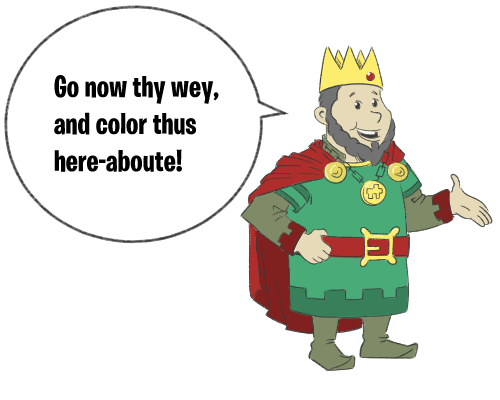 The King likes to talk fancy! |
We've got family-friendly coloring books for kids of all ages! King's Castle Coloring Books include geometric designs, weird cartoon characters, fun animals, cool cars, word games, mazes and puzzles! Free Samples, Right This Way! |
